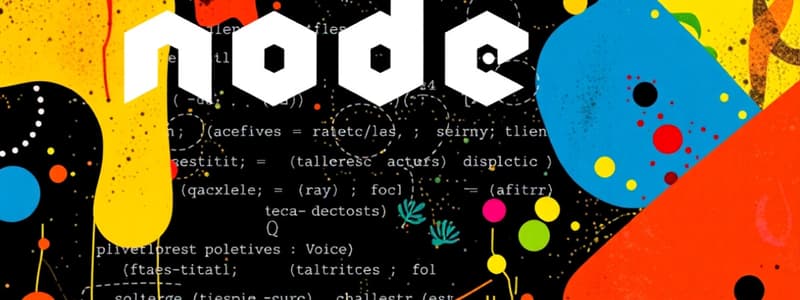Podcast
Questions and Answers
Which of the following best describes the functionality of two-way data binding in Angular?
Which of the following best describes the functionality of two-way data binding in Angular?
- Allows data to flow bidirectionally between the component and the view. (correct)
- Allows data to flow from the view to the component only.
- Allows data to flow between multiple components.
- Allows data to flow from the component to the view only.
What is the purpose of the app.component.ts file in an Angular project?
What is the purpose of the app.component.ts file in an Angular project?
- Contains the CSS styles for the main component.
- Defines the visual structure of the main component.
- Contains the configuration settings for the application.
- Defines the logic and behavior of the main component. (correct)
Which Angular directive allows you to conditionally render an HTML element based on a boolean expression?
Which Angular directive allows you to conditionally render an HTML element based on a boolean expression?
- `*ngStyle`
- `*ngModel`
- `*ngIf` (correct)
- `*ngFor`
Which Angular directive allows you to create two-way data binding for form controls?
Which Angular directive allows you to create two-way data binding for form controls?
What is the primary use of the *ngFor directive in Angular templates?
What is the primary use of the *ngFor directive in Angular templates?
Which of the following is NOT a type of data binding in Angular?
Which of the following is NOT a type of data binding in Angular?
In the Angular project file structure, where would you find the main application component?
In the Angular project file structure, where would you find the main application component?
Which of the following is NOT a benefit of using Angular for web application development?
Which of the following is NOT a benefit of using Angular for web application development?
What are the main advantages of using Node.js for web applications?
What are the main advantages of using Node.js for web applications?
Which component is crucial for the functioning of Node.js that allows it to manage multiple operations without blocking?
Which component is crucial for the functioning of Node.js that allows it to manage multiple operations without blocking?
What is the primary purpose of the package.json file in a Node.js project?
What is the primary purpose of the package.json file in a Node.js project?
Which statement correctly describes the Node.js event loop?
Which statement correctly describes the Node.js event loop?
What programming engine is Node.js built on?
What programming engine is Node.js built on?
Which type of applications is Node.js particularly well-suited for?
Which type of applications is Node.js particularly well-suited for?
What does NPM stand for in the context of Node.js?
What does NPM stand for in the context of Node.js?
Who developed Node.js?
Who developed Node.js?
What contributes to the high performance of MongoDB?
What contributes to the high performance of MongoDB?
Which of the following describes the role of Angular's controllers within its MVC architecture?
Which of the following describes the role of Angular's controllers within its MVC architecture?
What feature does MongoDB Compass offer to users?
What feature does MongoDB Compass offer to users?
Which data modeling technique in MongoDB minimizes data duplication?
Which data modeling technique in MongoDB minimizes data duplication?
What is a key benefit of Angular's component-based architecture?
What is a key benefit of Angular's component-based architecture?
What is the primary function of one-way data binding in Angular?
What is the primary function of one-way data binding in Angular?
Which aspect of MongoDB data modeling allows users to add data without predefined schema?
Which aspect of MongoDB data modeling allows users to add data without predefined schema?
In Angular, what is the purpose of directives?
In Angular, what is the purpose of directives?
What is the main benefit of using local modules in a Node.js application?
What is the main benefit of using local modules in a Node.js application?
Which of the following modules is used for manipulating file paths in Node.js?
Which of the following modules is used for manipulating file paths in Node.js?
Which statement is true regarding MongoDB's data storage format?
Which statement is true regarding MongoDB's data storage format?
What is one of the primary reasons for using NPM in JavaScript development?
What is one of the primary reasons for using NPM in JavaScript development?
Which of the following best describes third-party modules?
Which of the following best describes third-party modules?
What feature of MongoDB allows it to handle large volumes of data effectively?
What feature of MongoDB allows it to handle large volumes of data effectively?
What purpose does the http module serve in Node.js?
What purpose does the http module serve in Node.js?
Which module would you use to access file system operations in Node.js?
Which module would you use to access file system operations in Node.js?
Flashcards
What is Node.js?
What is Node.js?
Node.js is an open-source, cross-platform runtime environment that allows JavaScript to be executed outside of web browsers for server-side application development. It was created in 2009 by Ryan Dahl.
How does Node.js work?
How does Node.js work?
Node.js is built on Chrome V8, known for fast JavaScript execution. It handles concurrent operations efficiently using a single-threaded, event-driven architecture.
Why use Node.js?
Why use Node.js?
Node.js is fast due to the Chrome V8 engine, scalable due to its event-driven architecture, and suitable for real-time applications like chat or games.
What is package.json?
What is package.json?
Signup and view all the flashcards
What is the Node.js event loop?
What is the Node.js event loop?
Signup and view all the flashcards
What is a Node.js module?
What is a Node.js module?
Signup and view all the flashcards
Node.js Modules
Node.js Modules
Signup and view all the flashcards
Core Modules
Core Modules
Signup and view all the flashcards
Local Modules
Local Modules
Signup and view all the flashcards
Third-Party Modules
Third-Party Modules
Signup and view all the flashcards
NPM (Node Package Manager)
NPM (Node Package Manager)
Signup and view all the flashcards
http Module
http Module
Signup and view all the flashcards
MongoDB
MongoDB
Signup and view all the flashcards
MongoDB Scalability
MongoDB Scalability
Signup and view all the flashcards
High Performance in MongoDB
High Performance in MongoDB
Signup and view all the flashcards
MongoDB Shell
MongoDB Shell
Signup and view all the flashcards
MongoDB Compass
MongoDB Compass
Signup and view all the flashcards
MongoDB Data Modeling
MongoDB Data Modeling
Signup and view all the flashcards
Embedded Data Model
Embedded Data Model
Signup and view all the flashcards
Normalized Data Model
Normalized Data Model
Signup and view all the flashcards
Angular
Angular
Signup and view all the flashcards
Model-View-Controller (MVC) in Angular
Model-View-Controller (MVC) in Angular
Signup and view all the flashcards
Two-way Data Binding
Two-way Data Binding
Signup and view all the flashcards
src Folder
src Folder
Signup and view all the flashcards
app Component
app Component
Signup and view all the flashcards
app.component.ts
app.component.ts
Signup and view all the flashcards
app.component.html
app.component.html
Signup and view all the flashcards
app.component.css
app.component.css
Signup and view all the flashcards
Angular Templates
Angular Templates
Signup and view all the flashcards
ngModel
ngModel
Signup and view all the flashcards
Study Notes
Node.js
- Node.js is an open-source, cross-platform runtime environment for JavaScript.
- It allows JavaScript to be executed on the server-side.
- It's built on Chrome's V8 JavaScript engine.
- It uses an event-driven and non-blocking architecture.
- This makes it efficient for handling multiple concurrent operations.
- Node.js is popular for building data-intensive applications due to its fast execution.
How Node.js Works
- The JavaScript engine compiles into efficient machine code.
- Node.js uses a single thread, event loop to handle requests.
- It uses an event-driven model to manage asynchronous operations without blocking.
Why Use Node.js?
- Fast execution speed due to Chrome's V8 engine
- Excellent for real-time applications
- Asynchronous and event-driven architecture
- Easier for the developer to use compared to server-side languages.
Package.json
- A manifest file for Node.js projects.
- Contains metadata, dependencies, scripts, and more.
- Essential in understanding and managing projects.
- The package.json file is the first step in learning about developed Node.js projects.
JSON Package File
- A fundamental component of Node.js projects.
- It manages metadata, dependencies, scripts, and configs.
- Provides information about the project's structure and components.
- Categorized into properties that define project metadata.
The Node.js Event Loop
- A mechanism in Node.js to handle asynchronous operations.
- Non-blocking I/O operations, enabling efficient use of resources.
- Continuously checks for tasks in a message queue, optimizing concurrency.
Modules in Node.js
- Core Modules: Built-in modules provided by Node.js
- Third-Party Modules: Modules from external sources, managed using NPM.
- Local Modules: Modules created within the project.
Core Modules
- Node.js includes core modules for common operations.
- Including:
http,fs(file system),path,os, andurlmodules, are essential to all Node.js development projects.
NPM (Node Package Manager)
- A package manager for managing external dependencies.
- It centralizes the process of installing, updating, and managing modules
- essential for the efficiency and flexibility of Node.js development projects.
HTTP Modules
- Part of Node.js for handling HTTP requests.
- It allows for creating and handling requests send from a client.
- Provides methods of creating, managing HTTP servers.
MongoDB
- A NoSQL database management system (DBMS).
- Stores data in JSON-like documents.
- Highly flexible and scalable, accommodating various data structures and relationships.
- Handles document queries quickly, unlike relational databases.
Mongo DB Shell
- A useful tool for database administration and interaction.
- Provides a powerful command-line interface for working with Mongo DB.
Key Features of MongoDB
- Flexible Data Model
- Horizontal Scalability
- High Performance
Data Modeling in MongoDB
- The process of organizing data for efficient storage and retrieval.
- Efficiently organizes and handles large amounts of data.
- Can be structured in a variety of ways, to fit the project's needs.
Normalization
- A technique of database design to reduce redundant data and improve data integrity.
REST APIs
- Representational State Transfer APIs
- A way to structure communication between servers and clients.
- Using HTTP methods (GET, POST, PUT, DELETE)
- Simple, scalable, and widely used in web applications.
Angular.js
- An open-source Javascript framework used to create single page applications (SPAs)
- A popular front-end framework for building user interfaces.
- Data-binding is a key aspect as is component-based, easy to learn and understand.
Data Binding
- The process of linking data between components and templates in Angular applications
- This allows for dynamic updates to the view when data changes.
- Makes web apps faster and more responsive.
Component Directory Structure
- Organizing application code to improve maintainability.
- This structure makes it easier to manage and grow the size of an app.
Studying That Suits You
Use AI to generate personalized quizzes and flashcards to suit your learning preferences.




